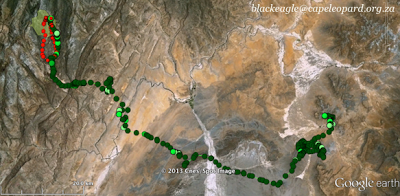To the Karoo and Back: Mate replacement & GPS tracking an ousted eagle.
The Verreaux’s (Black) Eagle is commonly
thought to be monogamous and with a pair bond that probably lasts for years
(Gargett 1990, Steyn 1982). Adults are reported to show a strong fidelity to
their breeding territory, but non-breeding birds, especially sub-adults
possibly move significant distances (Gargett 1990). Territorial behavior occurs
usually when a single intruding adult imposes upon the territory of a resident
pair. This is displayed as descending aerial cartwheels with the feet of
opposing individuals clasped, only releasing grip shortly before reaching the
ground (pers. obs., Gargett 1990,
Simmons & Mendelsohn 1993). It is not known whether or not these conflicts
often result in injuries or fatalities but my observations have always ended
with the resident pair chasing away the intruding bird.
So when an eagle which was equipped GPS
seemed to apparently disappear we were very surprised by the story which slowly
unfolded…
I began monitoring the pair discussed here in
2011; that year they bred successfully. On 6th
April 2012 the male of this pair was fitted with a University of Amsterdam
Bird Tracking System (UVA-BiTS) GPS device. At the time I assumed this pair
were the same individuals that bred in 2011, but I now note that this is an
assumption not a fact.
The UvA-BiTS tag can take GPS fixes up to
every 3 seconds depending on the solar charge. The data is stored onboard and
transmitted back by a ground station network which can be set up over a chosen
area. In this case the ground station network was active over approximately
half of the home range of this eagle, which allowed regular daily contact from
the tag.
While carrying out fieldwork on 13th
May 2012 two adult eagles were seen in the vicinity of the nest. They were
first observed at 14:09 when one was circling above the cliff while the other
was perched on the same cliff as the nest. They were also seen flying and
perching together and hence appeared to be a “pair”. However, the GPS tag we
had fitted was no longer there. The last GPS position that was received by the
ground network was fixed at 12:44 on the same day. So either the tag fell off
and this was the same pair or the eagle was replaced and re-paired in less than
85 minutes of the previous male leaving the territory… It seemed impossible…
The true
story was not revealed until five months later when the tag came back into
contact with the ground network which was functioning in a neighboring area of
the Cederberg to download data from another tagged eagle. The eagle had left
the territory rapidly after 12:44 on the 13th May 2012 and had
stored all further GPS fixes onboard until reconnecting with the network.

Figure 2: GPS points from 13th – 15th May (green) and 15th May to 17:23 on 27th June 2013 (orange).
So we now know, after being ousted from it’s
territory the eagle initially covered 110km in the first two days (Figure 1)
and then appears to have taken up a new ‘base’ 75km away from its former
territory. The data collected shows a massive expansion of the area used by
this eagle following displacement. It also showed three return trips to and
from the Cederberg up to the June 27th, but only once did it
actually pass over the kloof where the former nest site is. We remain to see if
this eagle will re-pair. During the 2012 breeding season the newly formed pair
did not breed. Mate changes of Verreaux’s Eagles probably occur more frequently
than we manage to observe, this data supports the idea that re-pairing is so
rapid that it is difficult to detect without intensive monitoring.
This week I followed this eagle’s path to the Karoo and back with the download system, I spent four days looking for him at the last known location but with no luck. I cannot conclusively say where he is know – perhaps he is still there but was a typically illusive Verreaux’s, or perhaps he has found a new breeding site too. I only hope that one day we will hear from him again to find out the ending of this story.
|
Figure 3: The “team” searching for the GPS tag with the UVA-BiTS base station.
|
References
Gargett, V. 1990. The Black
Eagle, A Study. Acorn Books, South Africa.
Simmons,
R.E. & Mendelsohn, J.M. 1993. A critical review of cartwheeling
flights
of raptors. Ostrich 64: 13-24.
Steyn, P. 1982. Birds of Prey of
Southern Africa. David Philip, Cape Town.





Good work - you may enjoy this sequence of shots of a Black Eagle landing... http://bluehillescape.blogspot.com/2013/03/the-black-eagle-has-landed.html
ReplyDelete